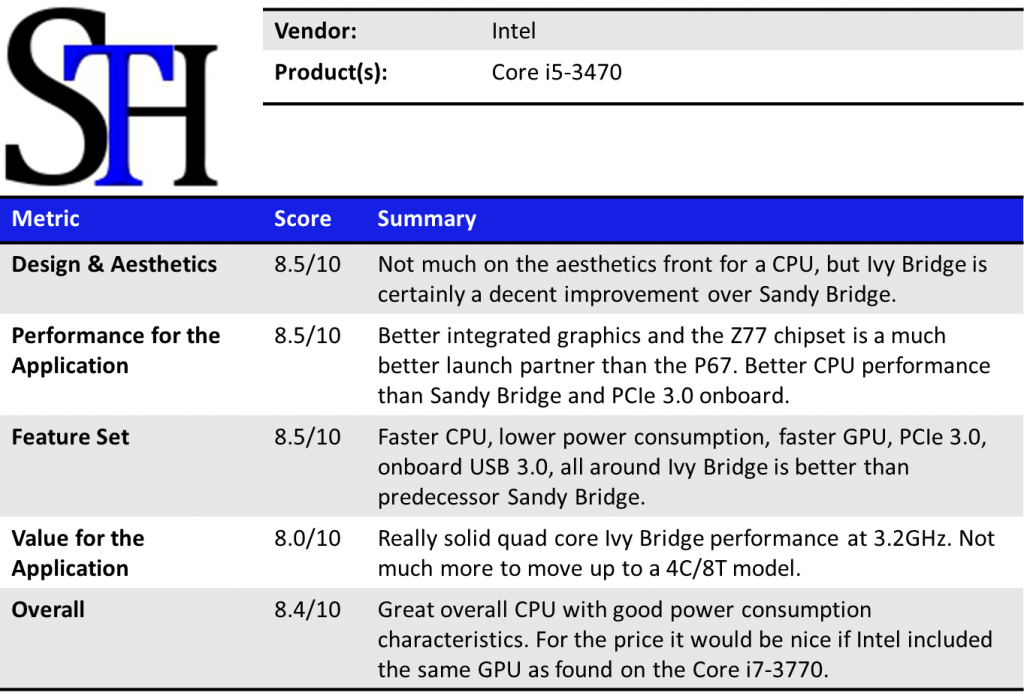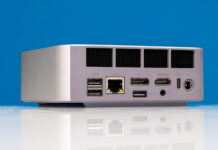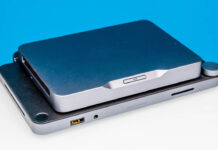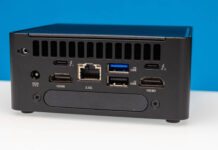At the initial Ivy Bridge launch in Q2 2012, Intel released both the Intel Core i5-3470 and Core i5-3450. The latter model suffered a 100MHz clock speed disadvantage over the Core i5-3470. Pricing was set very interestingly, both chips would retail in the $190 to $200 range. Personally, I would chose the Intel Core i5-3470 every time. given the $5 street price difference. Although the Core i5 line does not support ECC memory, it is still very popular in servers and workstations. The Intel Core i5-3470 CPU has onboard HD 2500 graphics which is enough for many non-gaming workloads. Furthermore, with four native cores and Intel Turbo Boost, the processor is very fast. Some workloads see either no benefit from Hyper-Threading or even a penalty, so in these cases saving money and using a lower cost Intel Core i5-3470 CPU can be very attractive. As we are going to see, the Intel Core i5-3470 is a solid CPU choice for the money.
Test Configuration
The trend with Z68 and Z77 chipsets are that the integrated GPUs are more than adequate for basic 2D output. If you are looking for a workstation with a lot of CPU need but where 3D GPU performance was not needed, then Intel’s on-die graphics are going to be “good-enough” for many users one one can use the third-gen PCIe slots for more I/O performance. With that being said, most Z77 buyers will still use discrete GPUs.
- CPU(s): Intel Core i5-3470
- Motherboard: ASUS P8Z77-V Pro
- Memory: 32GB (4x 8GB) G.Skill Ripjaws Z DDR3 1600
- Drives: Corsair Force3 120GB, OCZ Vertex 3 120GB
- Chassis: Norco RPC-4220
- Power Supply: Corsair AX850 850w 80 Plus Gold + PicoPSU 150XT with 150w power supply.
Intel Core i5-3470 Performance Tests
I will start off this section by saying that the standard test suite was built to test 1-8 thread single CPU systems. Examples are Sandy Bridge and Ivy Bridge Intel Xeon CPUs. Over time, we have been slowly altering the mix. Clearly, one would expect a different workload between dual Intel Xeon E5-2690 CPUs and something found in a low-end, low-power server like an Intel Pentium G2120. Moving to the 16-64 core realm where the AMD Opterons and Intel Xeon E5 CPUs dominate, it will become ever more important to develop a second test suite.
Cinebench R11.5
We have been using Cinebench benchmarks for years. Cinebench has been added to the test suite because it does represent a valuable benchmark of multi-threaded performance. We have had quite a few readers contact me about this type of performance for rendering performance. Cinebench R11.5 is something that anyone can run on their Windows machines to get a relative idea of performance. After seeing Cinebench scale from one to 64 cores, it has become a favorite.
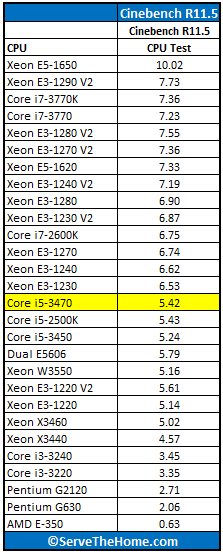
Looking at some of the Cinebench benchmark results, there is a well defined mid-range. One can see that the Intel Core i5-3470 falls squarely in the middle of the range. For a $5 premium over the Core i5-3450, I think it is well worth the money spent.
7-Zip Compression Benchmark
7-Zip is an immensely popular compression application with an easy to use benchmark.
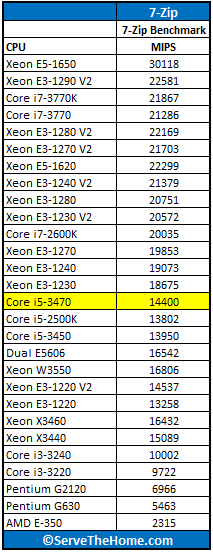
From a price to performance perspective, the Intel Core i5-3470 is in-line with expectations. Having a native quad core architecture helps the Intel Core i5-3470 in the 7-Zip compression test. Price wise, it is about one third more than the Core i3-3220 and we see just over one third more performance from the Intel Core i5-3470.
TrueCrypt Encryption Benchmarks
With Intel’s focus on its AES-NI features TrueCrypt can look a bit skewed. Unlike some dubious drivers over the years that were optimized for benchmarks over real world application, Intel’s AES-NI feature does encompass the addition of specialized hardware. This specialized hardware has many practical uses. For example, users of Solaris 11 can utilize the AES-NI features to see much higher throughput on encrypted volumes. AMD has started offering AES acceleration so it is a good test for most CPUs now.
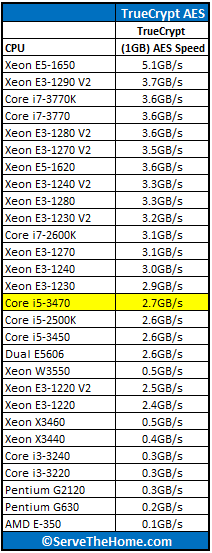
After having just benchmarked chips like the Intel Core i3-3220, this is a welcome change. Having hardware support for AES encryption in the Intel Core i5-3470 helps a lot.
Handbrake 0.9.5 x264 Encoding Benchmarks
We are still using Handbrake v0.9.5. This is just to keep a consistent look at CPUs that have been tested with v0.9.5. We will begin to collect data on v0.9.6 and start using that once we have critical mass. Either way, Handbrake is an extremely popular x264 encoding and transcoding application. It is very common practice these days to encode video for mobile devices. Quick transcoding is an important CPU application.
Again, the only thing to note here is that this chip falls in-line with quad core Intel performance expectations. With the new Windows 8 test suite, we will be re-vamping the Intel Core i5-3470 results for things such as Handbrake transcoding.
Power Consumption
Power consumption is a top concern for hardware manufacturers. We test using an Extech 380803 True RMS power analyzer. It is a really nice unit that even records usage over time.
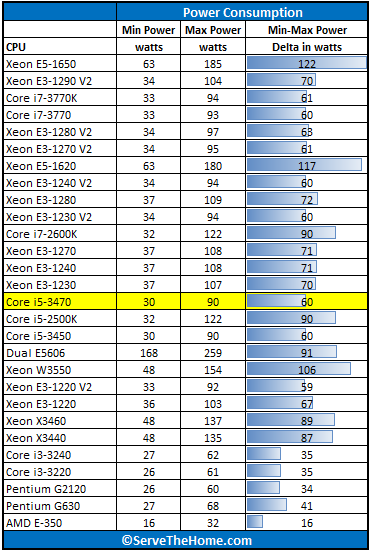
Power consumption on the Intel Core i5-3470 is in-line with expectations. Despite having a 3% performance advantage over the Core i5-3450, the Intel Core i5-3470 has very similar power consumption characteristics.
Conclusion
First off, I think the Intel Core i5-3470 is a great workstation CPU. Stepping up for around $50 over the Core i3-3240 gains a user a lot of features and a lot more performance. I do wish that Intel added ECC to the Core i5 and i7 lines and that the company standardized on the HD 4000 graphics instead of segmenting the product line. I think it is an decision to go with the Intel Core i5-3470 at $199 over the Core i5-3450 at $195. If I was looking for a solid processor for Windows 8, the Intel Core i5-3470 is a great mid-range option.
